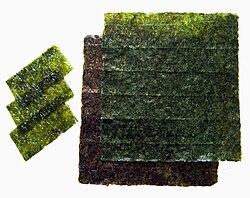Нори
Нори (海苔) је јапански назив за различите врсте јестивих морских алги које спадају у црвене алге порфира (Porphyra); укључујући најистакнутије врсте P. yezoensis и P. tenera. Готов производ се добија исушивањем и скупљањем алги, сличан производњи папира. Јапан, Кореја и Кина су тренутно највећи произвођачи нори алги.

Раније се под називом нори мислило на много више врста алги него што је то случај данас; па је тако и алга Хиџики спадала у ту групу. Један од најранијих описа алге нори налази се у Тајхо законику из 701. године, где се спомиње њено опорезивање. Нори се раније припремао у виду каше а тек касније у току Едо периода, у Едо четврти Асакуса, створен је нори у облику танких листова који се и данас тако обрањује. Овај поступак обраде води порекло од јапанског начина прављења папира.
Нори се састоји од 1/3 протеина и 1/3 јестивих влакана. Садржи висок постотак јода, каротена, витамина А, Б и Ц, као и значајну количину калцијума и гвожђа. Док храњива вредност нори алге може да варира, у просеку 100 грама исушеног јаки-нори саджи:
- Протеини - 41.4г
- Масти - 3.7г
- Јестива влакна - 36.0г
- Калцијум - 280мг
- Магнезијум - 300мг
- Калијум - 2.4мг
- Јод - 6мг
- Цинк - 3.6мг
- Гвожђе - 11.4мг
- Витамин А (β-каротен) - 25мг
- Витамин Е - 4.6мг
- Витамин К - 390μг
- Витамин Б1 - 690μг
- Витамин Б2 - 2.33мг
- Витамин Б3 - 11.7мг
- Витамин Б6 - 590μг
- Витамин Б12 - 57.6μг
- Витамин Б9 - 1.90μг
- Витамин Б5 - 1.18мг
- Витамин Ц - 210мг
Литература
уреди- Merriam-Webster Dictionary
- Kodansha encyclopedia of Japan, Volume 6. Kōdansha. 1983. ISBN 978-0-87011-620-9. стр. 37. "The word nori is used in Japan both as a general term for seaweed and as a name for a species of red algae (Porphyra tenera) that is commonly used as a foodstuff and is also known as asakusa- nori."
- Ragan, Mark A., ed (1987). Twelfth International Seaweed Symposium: proceedings of the Twelfth International Seaweed Symposium : held in Sao Paulo, Brazil, July 27-August 1, W. Junk. 1986. ISBN 978-90-6193-644-2. стр. 5.. "In the Law of Taiho (AD 701) which was established by the Emperor at that time, marine algae such as Laminaria, Undaria and its sporophyll, Porphyra and Gelidium are included among marine products which were paid to the Court as tax."
- Nishizawa, Kazutoshi (2002). Seaweeds kaiso: bountiful harvest from the seas : sustenance for health & well being by preventing common life-style related diseases. Japan Seaweed Association. "In the Law of Taiho (AD 701) which was established by the Japanese Fortysecond Emperor (Monmu-Tenno, 697-707) at that time, marine algae such as Laminaria, Undaria and their sporophyll, Porphyra and Geridium were paid to the Court as a tax."
- Hiroshi, Terayama (2003). 和漢古典植物考 (Japanese and Chinese Classical Botany). asaka Shobō. pp. 588. "There is a description "local peoples was drying nori" in Hitachi Province Fudoki (721–721), and also there is a description "nori was harvested" in Izumo Province Fudoki (713–733). These show nori was used as food from ancient times."
- Shimbo, Hiroko (2001). The Japanese kitchen: 250 recipes in a traditional spirit. Harvard Common Press. стр. 128. ISBN [[Посебно:BookSources/978-1-55832-177-9 "Unlike wakame, kombu, and hijiki, which are sold in the form of individual leaves, nori is sold as a sheet made from small, soft, dark brown algae, which have been cultivated in bays and lagoons since the middle of the Edo Era (1600 to 1868). The technique of drying the collected algae on wooden frames was borrowed from famous Japanese paper-making industry."|978-1-55832-177-9 "Unlike wakame, kombu, and hijiki, which are sold in the form of individual leaves, nori is sold as a sheet made from small, soft, dark brown algae, which have been cultivated in bays and lagoons since the middle of the Edo Era (1600 to 1868). The technique of drying the collected algae on wooden frames was borrowed from famous Japanese paper-making industry."}-]] Проверите вредност параметра
|isbn=: invalid character (помоћ).